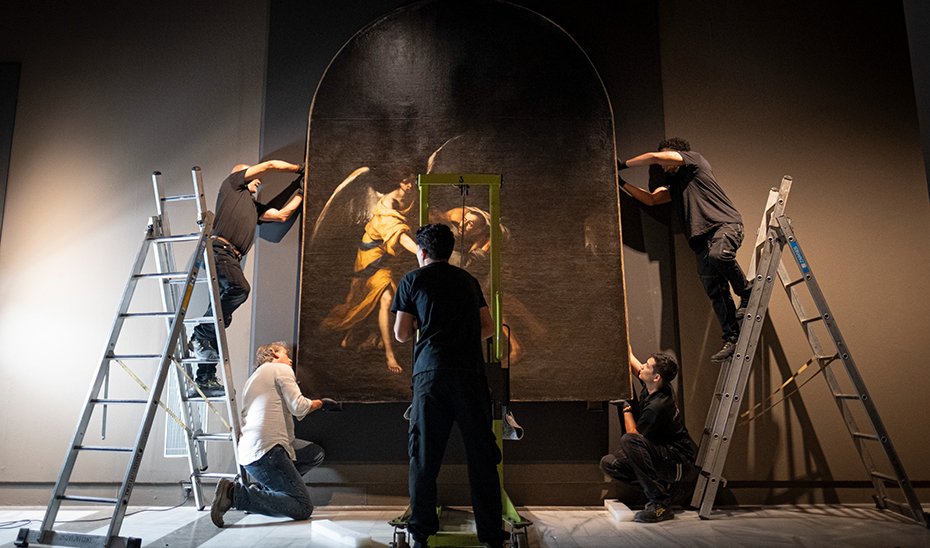The exhibition ‘Art and Mercy. La Santa Caridad de Sevilla’ will open its doors on July 1st at the Museum of Fine Arts in Seville. The exhibition will offer a unique opportunity to see up close masterpieces by Bartolomé Esteban Murillo, Juan de Valdés Leal, and Pedro Roldán that are usually displayed at great heights or part of altarpieces in the church of Señor San Jorge of the Brotherhood of Santa Caridad.
The exhibition is the result of collaboration between the Ministry of Culture and Sports and the charitable organization, whose facilities – the church and the hospital – are currently undergoing rehabilitation work, which is why a selection of outstanding pieces from their magnificent art collection are on display at the Seville art gallery.
The Minister of Culture and Sports, Patricia del Pozo, highlighted that visitors will be able to see in this exhibition «a selection of the most outstanding works of the church of Señor San Jorge and the Hospital of La Caridad«, in what will be a «unique opportunity to delve deep into one of the peaks of the Baroque, allowing direct access to works by Murillo, Valdés Leal, Pedro Roldán, and Duque Cornejo».
The exhibition at the Museum of Fine Arts will occupy the entire temporary exhibition room, divided into three different areas: the first dedicated to Valdés Leal, the second to Murillo, and the third focused on the different sculptures made for the church of this institution, which has its origins in the 15th century and is dedicated to the care of the most disadvantaged.
Among the works presented in ‘Art and Mercy. La Santa Caridad de Sevilla’ are the two paintings by Valdés Leal that most citizens associate with the institution promoted by Miguel de Mañara, who was its elder brother in the 17th century: ‘Finis Gloriae Mundi’ and ‘In Ictu Oculi’, better known as the ‘Last Things’. They are joined by a portrait of Mañara painted by this Sevillian artist.
The ‘Last Things’ are part of the iconographic design conceived by the former elder brother of the Charity for the church, for which he also sought the services of Murillo. In this exhibition at the Museum of Fine Arts, seven works by this artist can be seen: ‘The Multiplication of the Loaves and Fishes’, ‘Moses Striking the Rock at Horeb’, ‘Saint Elizabeth of Hungary Curing the Lepers’, ‘Saint John of God Transporting a Sick Person’, ‘The Incarnation’, ‘Child Jesus’, and ‘Child Saint John the Baptist’.
In addition to these paintings, the Seville museum will exhibit sculptures such as the Virgin of Charity, an anonymous polychrome carving by Valdés Leal, the two lamp-bearing angels by Pedro Duque Cornejo, the ‘Ecce Homo’ by the brothers Francisco and Miguel García, and three works by Pedro Roldán, the Christ of Charity, Saint George, and Saint Roch.
Mañara’s Iconographic Program
This hospital in the Arenal area, home to the Brotherhood of the Holy Charity of Our Lord Jesus Christ of Seville, has its origins in the 15th century and was created with the purpose of assisting the sick and needy, as well as giving Christian burial to the executed and drowned in the Guadalquivir. The construction of the church of San Jorge was carried out in several stages, with a first phase between 1645 and 1662, in which the foundations were laid and the initial walls were erected.
However, it was not until 1667, thanks to the determination of Miguel de Mañara, that the body of the church was completed. A year later, the head of the temple would be built, the sacristy, culminating in 1721 with the final stages. The facade of the current church is the result of various modifications to the original, and was definitively configured in the 18th century, with the characteristic tile panels by the ceramist José García and the clay sculptures attributed to Pedro Duque Cornejo.
The exhibition aims to explore the iconographic program that Miguel de Mañara conceived for the temple of the Hospital of the Holy Charity, where the integration of architecture, sculpture, and painting offers a significant example of the Baroque’s approach to total artwork, with a paradigmatic use of the public staging of religiosity imposed on the Church after the Council of Trent.

